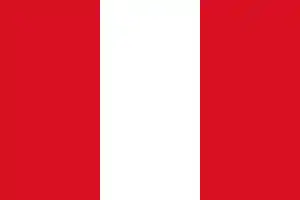Corruption in Peru
Transparency International's 2016 Corruption Perception Index ranks the country 101st place out of 176 countries.[1]
| Political corruption | ||||||||||||
|---|---|---|---|---|---|---|---|---|---|---|---|---|
 | ||||||||||||
| Concepts | ||||||||||||
| Corruption by country | ||||||||||||
|
||||||||||||
History
Fujimori government
Peru's most prominent political corruption scandal is probably the case of Alberto Fujimori, Peru's ex-President. Fujimori has been convicted of having ordered killings, embezzlement of public funds, abuse of power and corruption during his 10 years of presidency (1990-2000). In 2006, Fujimori fled to Japan with an alleged USD 600 million of public assets. He has been sentenced to a total of more than 30 years in prison.[2]
During his rule, Fujimori helped to maintain the government's image of honesty by using his advisor, Vladimiro Montesinos, to carry out the administration's corrupt procedures.[3] Montesinos served as the head of the National Intelligence Service (SIN) where he systematically bribed politicians, judges, and the news media.[4] An empirical analysis of Montesinos' corruption conducted by John McMillan and Pablo Zoido describes how Montesinos used over 75% of SIN's unsupervised budget to bribe over 1,600 individuals.[5] McMillan and Zoido estimate that at the height of the scandal more than U.S.$3.5 million was being paid monthly to various congressmen, judges and media executives.[6] The most common bribes were paid to television-channel owners which allowed Fujimori's administration to control the media and politically influence Peruvians.[7]
Recent history
After further scandals and facing a second impeachment vote, Pedro Kuczynski, his successor, resigned the presidency on 21 March 2018 following the release of videos showing alleged acts of vote buying, presenting his resignation to the Council of Ministers.[8][9] As a result of the Odebrecht scandal and other controversies, in 2018 all of Peru's living former president were either imprisoned or the focus of corruption investigations.[10]
Bribery
Irregular payments and bribes are often demanded from companies operating in Peru, and government contracts are often awarded to well-connected companies. Many companies experience the demand for facilitation payments as a result of Peru's extensive bureaucracy.[11]
See also
References
- e.V., Transparency International. "Corruption Perceptions Index 2016". www.transparency.org. Retrieved 2017-12-20.
- "Freedom in the World- Peru". Freedom House. Retrieved 6 February 2014.
- McMillan, John, and Pablo Zoido (2004). How to Subvert Democracy: Montesinos in Peru. Journal of Economic Perspectives 18.4 (2004): 70
- McMillan, John, and Pablo Zoido (2004). How to Subvert Democracy: Montesinos in Peru. Journal of Economic Perspectives 18.4 (2004): 70
- McMillan, John, and Pablo Zoido (2004). How to Subvert Democracy: Montesinos in Peru. Journal of Economic Perspectives 18.4 (2004): 73
- McMillan, John, and Pablo Zoido (2004). How to Subvert Democracy: Montesinos in Peru. Journal of Economic Perspectives 18.4 (2004): 82
- McMillan, John, and Pablo Zoido (2004). How to Subvert Democracy: Montesinos in Peru. Journal of Economic Perspectives 18.4 (2004): 70
- "PPK renunció a la presidencia del Perú tras 'keikovideos' | LaRepublica.pe". La República (in Spanish). 21 March 2018. Retrieved 21 March 2018.
- "PPK renunció a la presidencia del Perú". Gestión (in Spanish). 21 March 2018. Retrieved 21 March 2018.
- "LatAm in Focus: Why Peru's Political Establishment Is Scared | AS/COA". Council of the Americas. Retrieved 2018-10-12.
- "Peru Corruption Profile". Business Anti-Corruption Portal. Retrieved 14 July 2015.